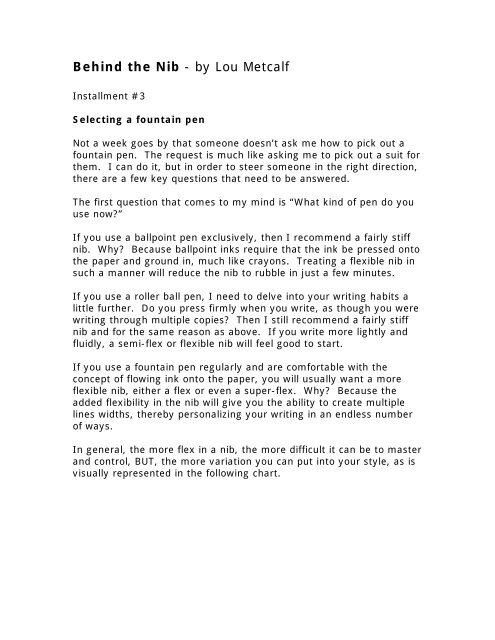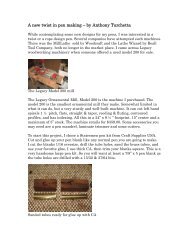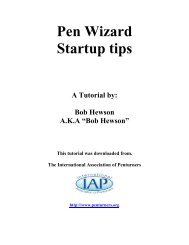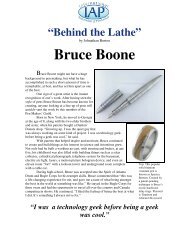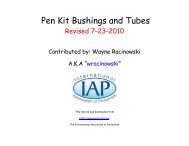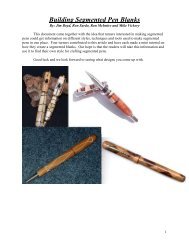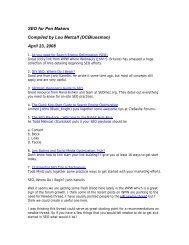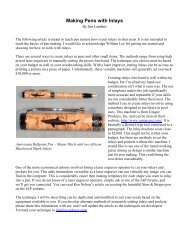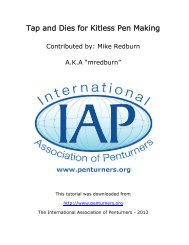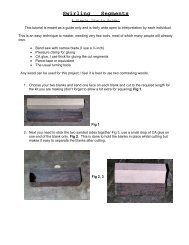Selecting a fountain pen
Selecting a fountain pen
Selecting a fountain pen
You also want an ePaper? Increase the reach of your titles
YUMPU automatically turns print PDFs into web optimized ePapers that Google loves.
Behind the Nib - by Lou MetcalfInstallment #3<strong>Selecting</strong> a <strong>fountain</strong> <strong>pen</strong>Not a week goes by that someone doesn’t ask me how to pick out a<strong>fountain</strong> <strong>pen</strong>. The request is much like asking me to pick out a suit forthem. I can do it, but in order to steer someone in the right direction,there are a few key questions that need to be answered.The first question that comes to my mind is “What kind of <strong>pen</strong> do youuse now?”If you use a ballpoint <strong>pen</strong> exclusively, then I recommend a fairly stiffnib. Why? Because ballpoint inks require that the ink be pressed ontothe paper and ground in, much like crayons. Treating a flexible nib insuch a manner will reduce the nib to rubble in just a few minutes.If you use a roller ball <strong>pen</strong>, I need to delve into your writing habits alittle further. Do you press firmly when you write, as though you werewriting through multiple copies? Then I still recommend a fairly stiffnib and for the same reason as above. If you write more lightly andfluidly, a semi-flex or flexible nib will feel good to start.If you use a <strong>fountain</strong> <strong>pen</strong> regularly and are comfortable with theconcept of flowing ink onto the paper, you will usually want a moreflexible nib, either a flex or even a super-flex. Why? Because theadded flexibility in the nib will give you the ability to create multiplelines widths, thereby personalizing your writing in an endless numberof ways.In general, the more flex in a nib, the more difficult it can be to masterand control, BUT, the more variation you can put into your style, as isvisually represented in the following chart.
Another consideration is the size of <strong>pen</strong>. Defining <strong>pen</strong>s as largemedium and small is extremely imprecise and can only give a buyer aballpark idea of what to look for. There is a slightly more scientificapproach which can be employed. This method is the result of a longstudy I did with two doctors from the National Institute of Arthritis andMusculoskeletal and Skin Diseases nearly three years ago. The tablebelow is not to be reproduced without specific permission andattribution. (email me for permissions and requirements)Pen Size GuidePen sizing is an inexact science or maybe just an art. In any case, here are myrecommendations based on my experience with many customers.Measure loosely around your hand. The measurement should be taken just to thepalm side of your knuckles and should not include your thumb.If the measurement is less than 8 inches, you will likely find our slender styles feelbest. If the measurement is 8-9½ inches, you will likely find the medium styles to feelbest. Over 9½ inches and our large styles will probably feel best.There's room for overlap here, and there is a lot to be said for personal taste. I havea customer who is a professional football player and writes with my slender <strong>pen</strong>s allthe time. Conversely, I have a lady customer who is 5' tall and barely 100 poundswho prefers the large <strong>pen</strong>s!


